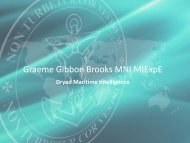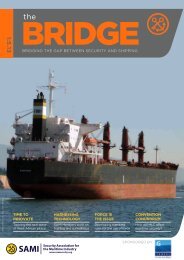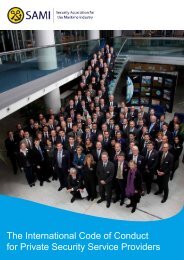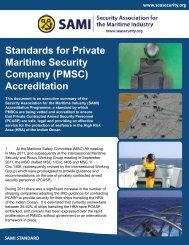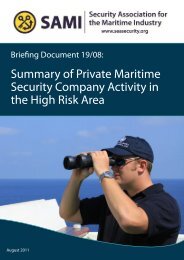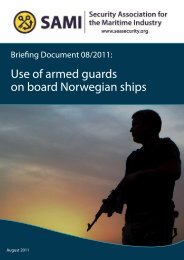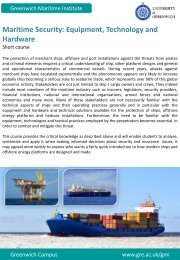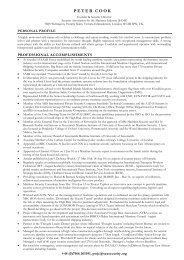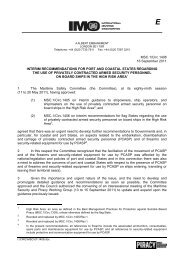C4.5.f. What are the different ways that social security can be provided under the MLC, 2006?The MLC, 2006 offers a high degree of flexibility to members States with regard tothe choice of means through which they can fulfil their obligation of providing socialsecurity to seafarers. Flexibility is provided for in that this obligation can be met:• through various bilateral <strong>and</strong> multilateral agreements or contribution-based systems(St<strong>and</strong>ard A4.5, paragraph 3);• through the additional flexibility that is provided as to the manner in which thecountry ensures protection. For example, St<strong>and</strong>ard A4.5, paragraph 7, recognizes thatit could be provided in laws or regulations or in private schemes or in collectivebargaining agreements or in a combination of these. Furthermore, if a contributoryscheme is chosen, it would seem reasonable (having regard to Guideline B4.5,paragraph 7) for the country of residence to expect the flag States concerned torequire that shipowners under their respective flags make the relevant contributions.C5. Title 5 Compliance <strong>and</strong> enforcement— What is the relationship between Title 5 <strong>and</strong>the other provisions in the MLC, 2006?As stated in paragraph 1 in the introductory provisions to Title 5:The Regulations in this Title specify each Member’s responsibility to fully implement <strong>and</strong>enforce the principles <strong>and</strong> rights set out in the Articles of this <strong>Convention</strong> as well as theparticular obligations provided for under its Titles 1, 2, 3 <strong>and</strong> 4.— Does the concept of substantial equivalenceapply to Title 5?As indicated in introductory paragraphs 2 <strong>and</strong> 3 of Title 5, the requirements of thisTitle cannot be implemented through substantially equivalent provisions [see A11. What isa “substantially equivalent” provision?].C5.1. Flag State responsibilitiesC5.1.a. What is a flag State?The term “flag State” refers to the country where a ship is registered <strong>and</strong>/or thecountry whose flag the ship is flying. Ships can, <strong>and</strong> often do, move from one country/registry/flag to another during the course of their operating lives. Under international lawthe flag State is the government that has authority <strong>and</strong> responsibility for regulating ships,<strong>and</strong> the conditions on board ships, that fly its flag no matter where they travel in the world.This is indicated in the Preamble to the MLC, 2006, which states:Recalling that Article 94 of the United Nations <strong>Convention</strong> on the Law of the Sea, 1982,establishes the duties <strong>and</strong> obligations of a flag State with regard to, inter alia, labourconditions, crewing <strong>and</strong> social matters on ships that fly its flag.Article 94 of the United Nations <strong>Convention</strong> the Law of the Sea, 1982, provides inparagraph1 that “Every State shall effectively exercise its jurisdiction <strong>and</strong> control inadministrative, technical <strong>and</strong> social matters over ships flying its flag.” The specificresponsibilities of flag States regarding inspection <strong>and</strong>, also in some cases, certification,that a ship <strong>and</strong> its operations including conditions for workers on ships (seafarers) meetsFAQ 39
agreed upon international st<strong>and</strong>ards are set out in the many international maritime<strong>Convention</strong>s adopted by the International <strong>Maritime</strong> Organization (IMO) <strong>and</strong> the ILO.C5.1.b. Can a flag State delegate its responsibilities?In accordance with Regulation 5.1.1, paragraph 3, of the MLC, 2006, a country may,where appropriate, authorize public institutions or other organizations (including those ofanother country) which it recognizes as competent <strong>and</strong> independent to carry outinspections or to issue certificates or to do both. In all cases, the delegating countryremains fully responsible for the inspection <strong>and</strong> certification of the working <strong>and</strong> livingconditions of the seafarers concerned on ships that fly its flag. In the MLC, 2006 theorganizations to which flag State tasks can be delegated are called “RecognizedOrganizations” (ROs).C5.1.c. Is there a model for a flag State inspection <strong>and</strong> certification system?Regulation 5.1.1, paragraph 2 requires flag States to establish an effective system forthe inspection <strong>and</strong> certification of maritime labour conditions ensuring that the working<strong>and</strong> living conditions for seafarers on ships that fly its flag meet, <strong>and</strong> continue to meet, thest<strong>and</strong>ards in this <strong>Convention</strong>. No model is prescribed for such a system, which, underSt<strong>and</strong>ard A5.1.1, must have clear objectives <strong>and</strong> st<strong>and</strong>ards covering the administration ofthe inspection <strong>and</strong> certification systems, as well as adequate overall procedures for thecountry’s assessment of the extent to which those objectives <strong>and</strong> st<strong>and</strong>ards are beingattained. In accordance with Regulation 5.1.1, paragraph 5, information about theinspection <strong>and</strong> certification system, including the method used for assessing itseffectiveness, must be included in the ILO Member’s reports to the ILO under Article 22of the Constitution (see Report Form). 33C5.1.d. What is a Recognized Organization (RO)?In the MLC, 2006 the organizations to which flag State tasks can be delegated arecalled “Recognized Organizations” (ROs) [see C5.1.b. Can a flag State delegate itsresponsibilities?] Regulation 5.1.2 <strong>and</strong> the Code establishes the requirements regarding theprocess for delegation/authorization of ROs. In many countries the organizations that areauthorized as ROs are ship classification societies that are also responsible for ship surveysincluding statutory certification of ships under IMO <strong>Convention</strong>s.C5.1.e. How is a Recognized Organization (RO) for a flag State authorized?St<strong>and</strong>ard A5.1.2 paragraphs 1 <strong>and</strong> 2 of the MLC, 2006 sets out requirements for flagStates that may wish to appoint public institutions or other organizations to carry outinspections required by the MLC, 2006, in accordance with normal practice. An up to datelist of any authorizations (<strong>and</strong> the scope of the authorization) for ROs must be provided tothe International <strong>Labour</strong> Office for publication (St<strong>and</strong>ard A5.1.2, paragraph 4).C5.1.f. What tasks can a Recognized Organization (RO) carry out?The tasks of each RO depend upon the tasks which the flag State concerned hasdelegated to it within the scope of those that an RO is permitted by the MLC, 2006 to carryout. Under Regulation 5.1.2, paragraph 1 of the MLC, 2006 <strong>and</strong> RO may only beauthorized by a flag State to carry out tasks that are expressly mentioned in the Code ofTitle 5 [see A9. What is the Code of the MLC, 2006?] as tasks that can be carried out by an33 See footnote 8.40 FAQ
- Page 8: C5.1. Flag State responsibilities .
- Page 11 and 12: the Convention regarding the need f
- Page 13 and 14: oard ships but are not directly inv
- Page 15 and 16: supervisory system (a system establ
- Page 18 and 19: A16. How does the MLC, 2006 make it
- Page 20 and 21: A19. What will happen to the mariti
- Page 22 and 23: B. Questions about the workers andt
- Page 27 and 28: authority?] as qualified to issue s
- Page 29 and 30: C1.3.b. Does this training requirem
- Page 31 and 32: It may be useful to also consider t
- Page 33 and 34: equirements for upgrading or promot
- Page 35 and 36: C2.3.h. Do the hour of rest and hou
- Page 37 and 38: C3. Title 3 Accommodation, recreati
- Page 39 and 40: y berths and lockers, chests of dra
- Page 41 and 42: C4.1.b. Must every ship have a ship
- Page 43 and 44: • the cost of safeguarding the pr
- Page 45 and 46: (b) facilities for sports and outdo
- Page 47: • Sickness benefit• Unemploymen
- Page 51 and 52: provisions of Regulation 5.1.3 and
- Page 53 and 54: C5.1.o. What is the period of valid
- Page 55 and 56: (b)(c)to carry out any examination,
- Page 57 and 58: prevents ships being delayed by unn
- Page 59 and 60: certificate and DMLC should be the
- Page 61 and 62: C5.2.q. Are complaints confidential
- Page 64 and 65: INTERNATIONAL LABOUR CONFERENCECont
- Page 66 and 67: Maritime Labour Convention, 2006MAR
- Page 68 and 69: Maritime Labour Convention, 2006(b)
- Page 70 and 71: Maritime Labour Convention, 20062.
- Page 72 and 73: Maritime Labour Convention, 2006Pla
- Page 74: Maritime Labour Convention, 20062.
- Page 78: Explanatory note to the Regulations
- Page 82 and 83: Minimum requirements for seafarers
- Page 84 and 85: Minimum requirements for seafarers
- Page 86 and 87: Minimum requirements for seafarers
- Page 88 and 89: Minimum requirements for seafarers
- Page 90 and 91: Conditions of employmentTITLE 2. CO
- Page 92 and 93: Conditions of employmentGuideline B
- Page 94 and 95: Conditions of employment3. National
- Page 96 and 97: Conditions of employment(a) hours o
- Page 98 and 99:
Conditions of employment4. Paragrap
- Page 100 and 101:
Conditions of employmentRegulation
- Page 102 and 103:
Conditions of employment(b) accommo
- Page 104 and 105:
Conditions of employmentciently and
- Page 106 and 107:
Accommodation, recreational facilit
- Page 108 and 109:
Accommodation, recreational facilit
- Page 110 and 111:
Accommodation, recreational facilit
- Page 112 and 113:
Accommodation, recreational facilit
- Page 114 and 115:
Accommodation, recreational facilit
- Page 116 and 117:
Accommodation, recreational facilit
- Page 118 and 119:
Accommodation, recreational facilit
- Page 120 and 121:
Health protection, medical care, we
- Page 122 and 123:
Health protection, medical care, we
- Page 124 and 125:
Health protection, medical care, we
- Page 126 and 127:
Health protection, medical care, we
- Page 128 and 129:
Health protection, medical care, we
- Page 130 and 131:
Health protection, medical care, we
- Page 132 and 133:
Health protection, medical care, we
- Page 134 and 135:
Health protection, medical care, we
- Page 136 and 137:
Health protection, medical care, we
- Page 138 and 139:
TITLE 5. COMPLIANCE AND ENFORCEMENT
- Page 140 and 141:
Compliance and enforcement(a) has t
- Page 142 and 143:
Compliance and enforcement7. Detail
- Page 144 and 145:
Compliance and enforcement14. A cer
- Page 146 and 147:
Compliance and enforcement5. If a M
- Page 148 and 149:
Compliance and enforcement(a) the i
- Page 150 and 151:
Compliance and enforcementGuideline
- Page 152 and 153:
Compliance and enforcement(c)(d)the
- Page 154 and 155:
Compliance and enforcementStandard
- Page 156 and 157:
APPENDIX A5-IThe working and living
- Page 158 and 159:
Appendix A5-IIThis is to certify:1.
- Page 160 and 161:
Appendix A5-IIMaritime Labour Conve
- Page 162 and 163:
Appendix A5-IISignature: ..........
- Page 166 and 167:
Appendix A5-IIThis Certificate is v
- Page 168 and 169:
APPENDIX B5-I - EXAMPLE OF A NATION
- Page 170:
Appendix B5-IDeclaration of Maritim




